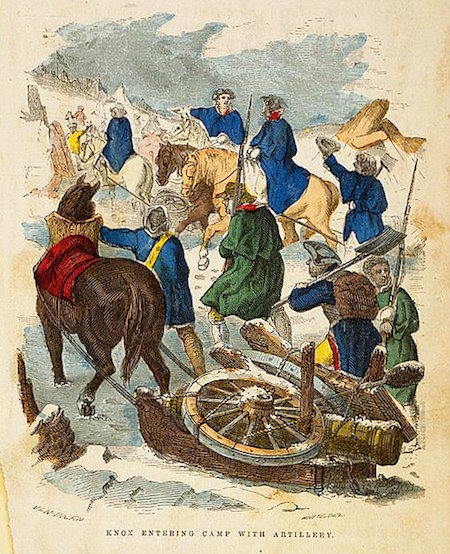What was Fort Ticonderoga?
Fort Ticonderoga was a small, dilapidated British fort maintained by the British at the southern tip of Lake Champlain in upstate New York. It was a strategically important fort in the French and Indian War, and was known then as Fort Carillon.
Why was it important?
Although it was manned by only 48 British soldiers, American forces recognized its geographic importance and its cache of cannon, guns, and other weapons. Fort Ticonderoga was located in a strategically important route between the colonies and England's Northern provinces (today Canada). The Massachusetts Committee of Safety authorized a secret mission that would be led by Colonel Benedict Arnold to seize the fort. Arnold helped in the effort to recruit 400 soldiers.
A Bloodless Seizure
As Arnold's mission traveled north, he learned that Connecticut had also planned a mission to seize the fort that was led by Ethan Allen and his Green Mountain Boys from Vermont. When Arnold finally reached Allen, the two worked out an agreement to share command of the mission. On May 10th, 1775, Allen, Arnold and 83 soldiers raided Fort Ticonderoga. The British soldiers, sleeping inside the fort, offered no resistance. No one was killed in the raid. After the surrender, as many as four hundred additional American soldiers arrived at the fort, promptly destroying it in search of liquor. Arnold was infuriated by the lack of discipline and regard by the Green Mountain Boys. Several of them became so sick of Arnold that they apparently drew their swords. Ethan Allen would take credit for the entire operation.
Arnold is Relieved of his Command
On May 11, Arnold led the seizure of nearby Fort Crown Point , which yielded more weapons and cannons. The first of Arnold's many perceived snubs occurred when he was relieved of command of the fort by Benjamin Hinman, who had come with 1,000 troops to help rebuild it.
Weapons Hauled 300 Miles to Boston
Despite Arnold's disappointment, the weapons obtained from the seizures of Forts Ticonderoga and Crown Point would prove extremely useful to the American cause. Commander-in-Chief of Continental forces, George Washington, put Colonel Henry Knox in charge of transporting the weapons for the defense of Boston. Knox and his men dragged 59 cannons on ox-drawn sleds over 300 miles from Fort Ticonderoga, through Albany, N.Y. and the mountains of Massachusetts, to Boston. The trip took 56 days. The entire load weighed more than 60 tons. When the cannons arrived in Boston, Washington ordered them positioned atop Dorchester Heights, overlooking the British fleet in the harbor below. On the night of March 4, 1776, Dorchester Heights would be fortified by 1,200 soldiers and the cannons were moved into place - all of which went unnoticed by the British. The British, astonished by the enormity of the work completed by the Patriots, were eventually forced to leave Boston and sail back to British territory in Halifax, Nova Scotia (Canada).
 |
Henry Knox Hauls the Artillery Taken from Fort Ticonderoga
|